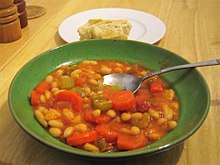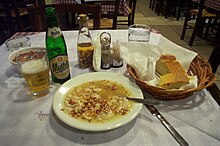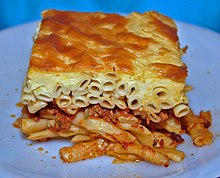The Greek cuisine is one of many great Mediterranean cuisines. Greece welcomes about 30 million visitors every year, and as such many beachgoers and cultural tourists will also get to know the delicacies of the Greek cuisine.
| Cuisines of Europe British & Irish • French • German (Bavarian • Franconian) Georgian • Greek • Italian • Nordic (Finnish) • Portuguese • Russian • Spanish |
Understand
[edit]
Salads and vegetables play an even bigger role than in other Mediterranean cuisines. Locally grown olives, tomatoes, cucumbers, eggplants and zucchini are to be found in countless dishes. In the north of the country rice is grown, and many wild herbs and vegetables growing in the mountains are used in local dishes.
Mountains cover 80% of the country, and shepherding is common, which is something that has made lamb meat and cheese (feta) important parts of the local cuisine. The long coastline and the large number of islands have in turn made fish and other seafood important parts of the local fare.
Regional cuisines frequently show influences from neighboring countries; in the north there are influences from different cuisines of the Balkan, Ottoman dishes and foodstuffs have been brought in from the east, and Arabian spices and dishes like pita, ground meat, cumin and cinnamon across the sea from the south.
The Orthodox Church and the periods of fasting have also influenced the cuisine. The fact that seafood and sweets are allowed to eat during fasting has created dishes like taramosalata (ταραμοσαλάτα, fish roe salad) and halva.
Ingredients and preparation
[edit]Common ingredients in the Greek cuisine are salads and vegetables, goat cheese and meat, fish, seafood, and olives. They're usually spiced with herbs and spices like oregano, mint, thyme, salvia, cinnamon and paprika.
The main dish is usually barbecued or baked. All meals come with bread, usually white bread.
Meal times
[edit]Like around the Mediterranean in general, breakfast is commonly made up of just a cup of coffee and a cookie.
Lunch is also rather light and often composed of sandwiches, salads, or fast food like gyros or souvlaki. Gyros is composed of meat layers spiced with olive oil and herbs, roasted on a rotating skewer and the outer layers are cut off and served. Souvlaki is another form of meat on skewer, served in a pita bread with onions, vegetables, tzaziki sauce and sometimes french fries (patates).
Dinner is the main meal, and in the hot summer months it's commonly eaten as late as 21:00 or 22:00. Non-touristy restaurants usually open for dinner at 19:30 or later, and people having dinner before that are easiliy recognized as tourists...
Restaurants
[edit]
The practice common in Central Europe and many other places where each guest gets their own main dish and sides on their own platter is rather uncommon in Greece, at least in traditional places.
When going to a restaurant, the waiter will direct you to a table (or you can ask if the table you'd like to sit at is vacant, locals will avoid the tables in the sun anyways...). When seated, the waiter brings a big jar of cool water and a basket of bread, then the waiter will take your drink orders and give you the menu. The menu is usually bilingual, in tourist destinations there will often be pictures of the dishes too. In such destinations you can also expect restaurant streets with touts standing outside each establishment trying to get you in.
In a Greek restaurant it's common that the person inviting to eat orders all dishes, and plenty of them. First a set of starters are placed in the middle of the table, and everyone can take as much as they like on their own plate. If the main dish is a barbecue, this too will be placed in the middle of the table for everyone to serve themselves. The same goes for salads, vegetables, patates (french fries with a Greek twist) and so on. Wine is often diluted by water, so that guests can drink more of it without getting intoxicated. Leaving a restaurant drunk is another thing that will mark you as a tourist. The meal is finished with a cup of coffee, and you will often get a free dessert with it. Like in much of the world, big dinners with family and friends continuing for hours and hours into the night are an important part of the local culture.
Types of places to eat and drink in Greece include:
- Bars (μπαρ) are places for having coffee, tea and alcoholic beverages; to eat there will be packed chips, crackers and small warm snacks.
- A taverna (ταβέρνα) is a normal restaurant. A fish taverna (ψαροταβέρνα, psarotaverna) is easily recognized as the "ψ" letter at the beginning reminds of the trident of Poseidon, the god of the sea in Greek mythology.
- An estiatorio (εστιατόριο) is an upscale restaurant.
- Finally, kafeneion (Καφενεῖον) denotes coffee houses where mostly older men sit at tafli (τάβλι) playing backgammon and discussing everything there is to be discussed long into the night. Formerly women weren't welcome in these establishments, nowadays this has changed somewhat and if you go with a man or are clearly a tourist there will usually not be a problem.
Typical dishes
[edit]Breakfast dishes
[edit]- Bougatsa (μπουγάτσα), sweet pie made of phyllo dough and a semolina custard filling
Starters (Orektiká)
[edit]

Starters are usually served cold, and sometimes with bread. These are some common starters in a Greek restaurant:
- Tsatsiki (τζατζίκι), yoghurt sauce with cucumber, garlic and olive oil
- Taramosalata (ταραμοσαλάτα), fish roe salad
- Tirokafteri (τυροκαυτερή) or Chtipiti (χτυπητή), feta cheese spread
- Melitzanosalata (μελιτζανοσαλάτα), eggplant salad made of grilled, mashed and spiced eggplants
- Skordalia (σκορδαλιά), garlic spread
- Fava (φάβα), a spicy spread with peas, caper, onions and olive oil
- Dakos or ntakos (ντάκος), chopped tomatoes, olive oil and feta on a dry bread
- Greek salad or farmer's salad (Greek: horiatiki salata, χωριάτικη σαλάτα), made with tomatoes, cucumber, red pepper, olives and feta cheese.
- Horta (χόρτα), salad of the wild vegetables of the season, spiced with lemon juice, eaten cold.
- Dolmadakia (Ντολμαδάκια), wine leaves filled with rice, spices and onion
- Chtapodosalata (Χταποδοσαλάτα), octopus salad
- Tiropita (τυρóπιτα), pie made of feta cheese
- Spanakopita (σπανακόπιτα), a savoury spinach pie, made with phyllo dough, feta cheese, onions or scallions, and eggs. A vegan version without the cheese and eggs is usually eaten for lent. May also be eaten as a standalone snack. Usually served warm.
Another thing common on menus are mezes, small bites that are often eaten with a shot of ouzo:
- Soupia tiganiti / psiti pan fried or barbecued cuttlefish
- Kalamaria tiganita/psiti pan fried or barbecued squid
- Chtapodi scharas, barbecued octopus arms with olives and/or vinegar
- Gavros, deep fried anchovies served with a sauce of olives and mustard, or just fresh off the barbecue
- Atherines tiganites, deep fried sand smelt
- Sardeles scharas, barbecued European sprat
- Saganaki (σαγανάκι), fried cheese
- Gigantes (γίγαντες), baked big white beans in tomato sauce
- Vegetables fried in olive oil are very popular as well:Melitzanes tiganites eggplant slices, Kolokithakia tiganita, zucchini slices, Piperies tiganites sweet or spicy pepperoni
Soups (Soupes) and stews
[edit]

Hot soups are eaten during the winter, but during summer cold soups are served.
- Chortosoupa (Χορτόσουπα) and Soupa Lachanikon (Σούπα λαχανικών) are vegetable soups
- Trachanas (Τραχανάς), made of grain mixed with yoghurt or fermented milk
- (Tanomenos) Sorvas (Τανωμένος σορβάς) or Pontian soup made up of groats or rice, made with yoghurt and mint
- Fasolada (φασολάδα), Greek bean soup, considered the national dish
- Fakes, lentil stew
- Revithosoupa (ρεβιθόσουπα), chickpea soup
- Fava soupa, pea soup
- Psarosoupa (ψαρόσουπα), fish soup, of which there are many different variants according to the fish. Mostly made with avgolemono (αυγολέμονο), egg-lemon sauce. The traditional fisherman's soup is called kakavia ( κακαβιά).
- Yiouvarlakia (γιουβαρλάκια) meatballs of ground beef meat and rice in avgolemono
- Kotosoupa (Κοτόσουπα ), chicken soup with rice, olive oil, onions and avgolemono
- Kreatosoupa (κρεατόσουπα), beef soup with potatoes, carrots and celery
- Patsas (πατσάς), tripe soup
- Magiritsa (μαγειρίτσα), lamb offal soup, eaten during Easter
Mains (Kyria Piata)
[edit]- Gemista (Γεμιστά), rice filled vegetables, mostly tomatoes, red peppers, eggplants or zucchini, occasionally potatoes
- Fasolakia (Φασολάκια), green beans in tomato sauce
- Bamies (Μπάμιες), okra in tomato sauce
- Briam (Μπριάμ), baked eggplants, zucchini and peppers
- Imam Baildi (Ιμάμ Μπαϊλντί), buttered eggplants with garlic
- Giouvetsi (γιουβέτσι), a stew with Kritharaki (Greek noodles) and lamb meat
- Moussaka (μουσακάς), a casserole with fried potato slices, ground meat, eggplants fried in olive oil and Béchamel sauce

- Pastitsio (παστίτσιο), a macaroni casserole with ground meat
- Gyros (γύρος), pork meat (occasionally chicken) roasted on a rotisserie, of which outer slices are cut off. In the fast food variant, available in fast food kiosks or restaurants (ψησταριά, psistariá), gyros is served in a pita bread. If gyros is on the menu in a restaurant (not very common) it will be served on a plate with fries and salads.
- Souvlaki (σουβλάκι), skewers with meat, generally lamb or pork, served in fast food and touristy places with a charcoal barbecue. Smaller lamb skewers have a long tradition in the rural cuisine.
- Kontosouvli (Κοντοσούβλι), a bigger version of souvlaki with pickled pork or lamb meat
- Stifado (στιφάδο), rabbit, veal or lamb stew with small onions and cinnamon, sometimes also made with octopus
- Bifteki (Μπιφτέκια), beef meatballs
Main dishes are usually served with Greek-style fries (patates, πατάτες), rice or kritharaki (Greek noodles) as well as vegetables such as green beans, eggplants or okra.
Fish is common in the form of soups, casseroles, marinated dishes, or on the barbeque. When it comes to meat, lamb and goat meat is common, as is chicken (κοτόπουλο, kotopoulo) and rabbit (κουνέλι, kouneli).
Desserts (Epidorpio)
[edit]
Traditionally fruits of the season or ice cream is eaten at the end of the meal. In addition, very sweet pastries from the Turkish and Middle Eastern cuisines that have formerly been enjoyed with the afternoon coffee are nowadays commonly also as desserts after meals:
- Baklavas (μπακλαβάς) a pastry of layers of filo dough with nut between them, drenched in syrup, also popular throughout the Middle East, North Africa, the Balkans, the Caucasus and Central Asia. The Greek version is typically made with walnuts, and what sets it apart from the Middle Eastern versions is that cinnamon is typically used to flavour the nuts, and honey is used to make the syrup.
- Galaktobureko (γαλακτομπούρεκο), a pastry of semolina custard in filo dough
- Kadaifi (κανταΐφι), a pastry of noodle treads
- Loukoumades (λουκουμάδες), oil baked cookie in honey syrup
- Moustalevria (μουσταλεβριά), grape pudding
- Halva (χαλβά), made of cinnamon, honey, licorice and sesame
- Yoghurt with honey and walnuts mixed in it is also a popular choice for dessert
Easter and Christmas pastries
[edit]There are multiple regional pastries during Easter. During Easter, painting eggs is also a popular pastime but unlike some other parts of the world, in Greece eggs aren't a notable food during Easter.
Pastries to enjoy during the Christmas season are melomakaroni (μελομακάρονο), egg-shaped pastries covered in honey, as well as kourampiedes (κουραμπιέδες), almond pastries covered in powdered sugar.
Drink
[edit]In restaurants in Greece, expect to get a pitcher or bottle of water and glasses on the table when you're seated.
Cool non-alcoholic
[edit]- Regular water (νερό, nero) is almost always served during the summer, free of charge. Non-carbonated water is much more popular than sparkling water (called "soda"), which is mostly drunk after the meal to help the digestion.
- Portokalada: orange soda is quite popular, as are other forms of orange beverages. Freshly squeezed orange juice is called himos portokaliou χυμός πορτοκαλιού. Fanta is available with or without carbonic acid.
- Orgeat, made of almonds, sugar, and rose water or orange flower water, is a sweet, non-alcoholic beverage, drunk on some islands. It's known as soumada (σουμάδα) on Chios and Nisyros and orzata on Kefalonia.
Alcoholic beverages
[edit]
- Unsurprisingly wine is an important part of the local culinary culture, and not only served in bottles but in tavernas also in copper or glass jars of a quarter, half or one liter. Formerly the wine barrels were placed in the dining room of the taverna, and diners could pick the barrel they wanted their wine from. Some notable wines are retsina (Ρετσίνα), a dry white wine with flavored pine resin, and cair, a sparkling wine from Rhodes which is toasted to the new year.
- Beer (μπύρα, Bira) is also quite common, though mostly in bottled form. For a long time, the market was dominated by the domestic Fix brand with Bavarian roots, nowadays it's joined by the newer brands Mythos and Alfa. Also the Dutch and German brands Amstel, Heineken, Löwenbräu and Henninger are locally brewed.
- Ouzo (ούζο), with an aroma of anise is drunk as aperitif, with mezes (chiefly seafood) or while waiting for the main food in tavernas. The island of Lesbos is particularly famous for its ouzo. On Crete and in northern Greece, ouzo is commonly mixed with some other alcoholic beverages, and in the former tsikoudia (τσικουδιά) is the most common aperitif. Just like with the manufacture of Italian grappa, there's an intermediate product when ouzo is distilled – here it's called souma and still served in rural bars and restaurants.
- The Patras region used to be famous for its liqueurs, but Italian brands largely took over the market over the course of the 20th century. The two notable major brands left are Mavrodaphne (Μαυροδάφνη) and Tentoura (τεντούρα).
- Tsipouro (τσίπουρο) is an unaged brandy, sometimes flavored with anise, and mainly distilled in Macedonia, Epirus and Thessaly.
- Metaxa (Μεταξά) is the most famous Greek brandy, and is made with a range of herbs.
Coffee, tea and milk
[edit]- Greek coffee (Ελληνικός καφές), "kafes", is made with ground coffee and served with or without sugar. When ordering coffee, tell if you want a single or "double greek", and how much sugar you want: no sugar (sketos), a little bit (me oligi) or plenty (βαρύγλυκο varigliko). Coffee roasteries are open to customers wishes when it comes to coffee blends. Though asking for Turkish coffee Tourkikos in a Greek café is since the 1974 invasion of Northern Cyprus regarded as a faux pas.
- Nescafé (Νεσκαφέ) is also very popular.
- Café frappé, locally known as frapes (φραπές) is a Greek invention, and the way to drink coffee during the hot summer months – Nescafé, ice cubes, water is mixed in a blender and served with or without milk.
- Tea usually means the domestic mountain tea. On Crete, herbal tea made of Cretan dittany is widespread.
- Fresh milk may be sold only for a few days after production (due to a law from the days before modern food processing), irrespective of how it has been processed. Due to this fresh milk is relatively expensive.
- Condensed milk is available in all shops, most variants with added sugar. Milk powder is, on the other hand, difficult to find.
Buy
[edit]
Self-caterers will find surprisingly well-stocked grocery stores (παντοπωλείων, Pantopoleion) in almost any village. For fruits and vegetables, though, markets and sales stands next to roads are better places. The selection depends on the season. Tomatoes, cucumbers, eggplants and zucchini are almost always available. Strawberries and cherries will emerge in the markets from May onwards, apples and peaches a bit later. During the fall you will find table grapes, the fruits of the winter are kiwis and oranges.
There are a range of different qualities and package sizes of olive oil. When used as salad dressing, the oil is commonly mixed with lemon juice, Greek vinegar (ξύδι, Xydi), salt and pepper, at the dining table. Balsamic vinegar is also a common salad dressing. Speaking of salads, feta cheese plays a central part in a Greek salad, and it can be bought packed or by the weight. Greek-manufactured cheese types elaborated outside Greece (e.g. Dutch gouda) tend to be of low quality. Yoghurt is widespread, albeit not as cheap as one might expect.
To buy meat, head to the butcher's shops, where you can commonly buy chicken, pork and lamb meat, in pieces, ground or made to souvlaki and bifteki, and sausages.
Bakeries (αρτοποιείο) are places to get white bread fresh out of the oven in the morning, and also savory turnovers filled with spinach and feta - these are handy snacks for excursions. "Sugar bakeries" (ζαχαροπλαστικής) usually have an impressive selection of pastries and cakes, but also sell locally made ice cream by the weight, much cheaper than at ice cream kiosks.
Culinary experiences in Greece are often dependent on the season; fruits and vegetables are at their best at harvest time, and different meat and fish too have their own seasons. Festivities, both religious, and non-religious, tend to have one or several dishes associated with them.

